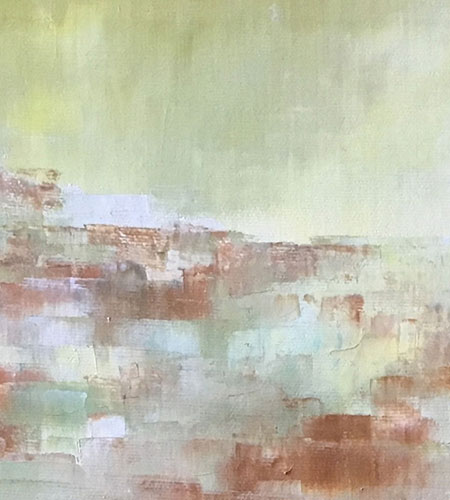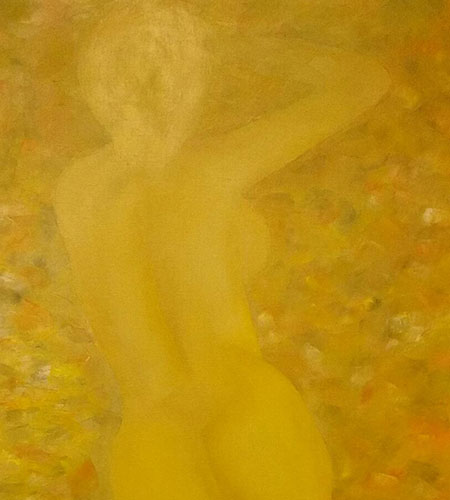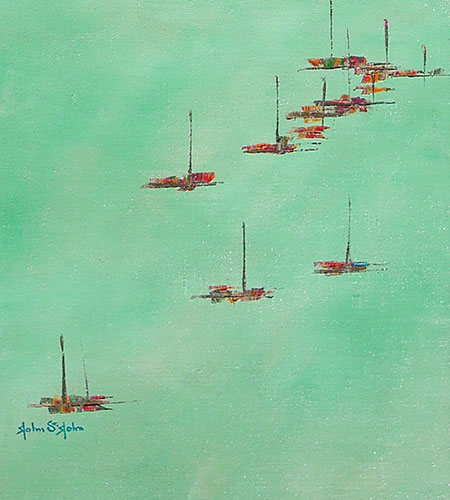Excerpt from "Visions of Reality in Oil Paintings"
It all began January 2, 1949 when I entered Norton Gallery and School of Art in West Palm Beach, Florida, to study watercolor pointing with Eliot O' Hara and charcoal portrait and life drawing with James Mallory Wilson. These two fine artists are teachers were the first of ten painters whose attitudes and techniques I would study during the next three years, as I began my second career.
Fortunately, I had neither sketched nor painted as a youth nor had I later been a week-end, amateur painter. This made it possible to approach my new career with the mental outlook of a young hopeful professional, in spite of the fact that I was thirty seven years of age.
My background in painting was unencumbered by aesthetic rigidity. There was a decided intellectual and cultural tradition in our family. We were inveterate readers. Our modest home held many great books and the Oak Park Public Library was like a second home. Before his untimely death, my father had purchased and designated an original oil painting for each of his four children.
I was privileged to have lived my childhood and to have had a public education in a culturally appreciative community such as Oak Park, Illinois. The school room walls had many original oil paintings and fine prints. Music appreciation classes consisted of listening to recorded music, accompanied by stories of the lives of the composers and their times. We often visited the Chicago Art Institute and the Field Museum of Natural History in Chicago.
However, I do not believe that I was emotionally or spiritually moved by these paintings, sculpture and graphic arts. They were a means of gaining an understanding of history and ways of life in other cultures. The craftsmanship was respected but I can't recall that I ever wanted to become a painter.
We were brought up to believe that we should make some contribution to the world, to leave something behind which would survive us, or to make the world a better place in which to live. To that end, I entered the Maxwell School of Public Administration at Syracuse University, after graduation from the University of Kentucky. After obtaining my Master's degree I worked in public administration in Tennessee, Washington D.C., Kentucky and Panama before entering the U.S. Army. My career in public administration ended with the termination of World War II.
During these years in state and federal service, my interest in painting, sculpture, graphic and mural art increased considerably. My first purchase of an oil painting was 1935 from a graduating classmate at the University of Kentucky. In following years, I acquired another oil, small watercolors, pencil sketches, Japanese wood block prints and an etching or two. All were given way or stored when I started my training in art schools.
Leaving the Norton School, successive months in 1949, 1950 and 1951 were spent in Sarasota, Florida, with instruction at Ringling School of Art; studies with Hilton and Dorothy Sherman Leech; and finally with Jerry Farnsworth and Helen Sawyer. Then on to Colorado Springs Fine Art Center and studies with Lawrence Barrett in lithography, and Vaclav Vytlacil in oils. Several weeks were spent in San Diego working with Doug Kingman. Mexico city College was my final stop in formal are education. There I worked with Jose Gutierrez in vinyl and fresco mural painting and etching with Lola Cuento.
It was Jose Gutierrez who suggested that I return to the United States and pioneer the exterior mural. Nothing seemed more challenging. Two years were required in Florida to work out the many technical problems involving vinyl formulas and the working methods for their use. Then I looked for walls to paint and a governmental body with the courage to commission such a major undertaking.
A bold City Commission in Coral Gables, Florida, gave me that opportunity early in 1955. Six months of research into Florida history preceded five months of work on the scaffolds to produce "Epochs of Florida History" for the "City Beautiful," the first exterior monumental mural on a public building in the United States. The following year, the city council commissioned me to restore the Denman Fink painting in the dome of the city hall and to execute "Landmarks of the Twenties," my own mural in the rotunda. In 1957, the City Council commissioned me to execute the first underwater public murals- "Pre-Columbian Art of the Americas" -in fountains close to the city hall. Unfortunately, these were never completed because of lack of funds. Public funds for murals were impossible to obtain in the late 1950s.
In seemed a good time to put public murals aside for awhile and grow as an easel painter; to evolve from the classic academic of my training to a manner of painting which was my own and reflected the world and life as I saw it.
In mid-1958 I moved to Old San Juan, Puerto Rico, settled in a third floor, windowless, railroad apartment with skylights and a balcony which allowed unbroken views of the sea, from the forts of San Cristobal to El Morroa, and with La Perla down below at the sea's edge. There I lived on La Calle del Sol and painted in great contentment for the first five years of what would become of twelve years of Puerto Rican living.
Life in Old San Juan and eventually in the countryside provided all the essentials for growth as a human being ad growth as an easel painter.
A warm and loving people, the Puerto Ricans open their hearts and their lives to others. Their customs, traditions and culture can only be a challenge to observe, understand and ultimately to share. Nature is at its finest from the cities and villages of the coastal plains, up into the hill country and higher into the green and verdant mountainland, up to El Yunque and the rain forest at the summit.
The atmosphere must be seen, felt and lived in. From early morning to mid-day to sundown, there may be a dozen changes. Freshness and clarity after the misty, light rains of torrential downpours give a brightness and clarity to the colors of natures. The mistiness of early morning is decidedly different from the water-saturated atmosphere in the jungle-like areas of dense vegetation.
The island is bounded on the north by the Atlantic Ocean with all the turmoil and unrest of a seething ocean, and on the south by the Caribbean with all the peace and lassitude of a passive sea.







